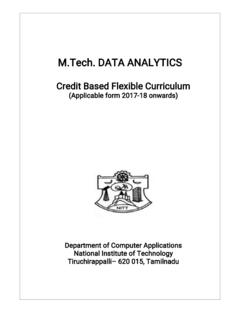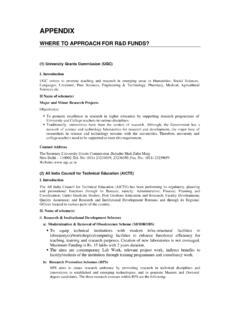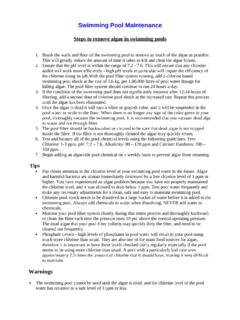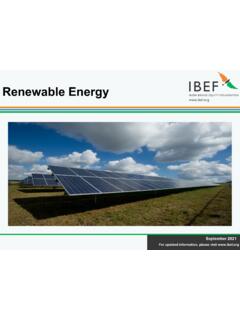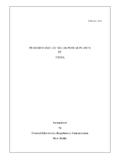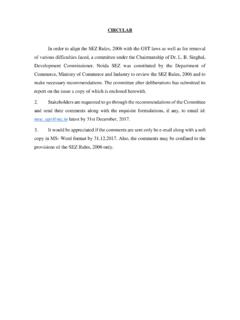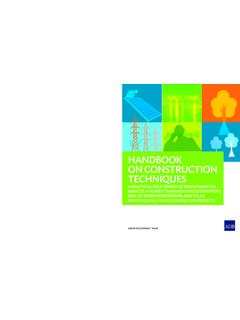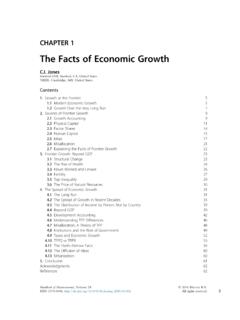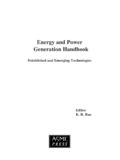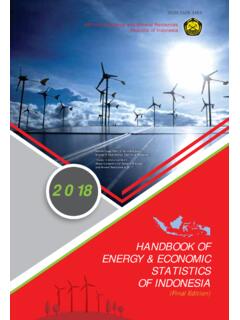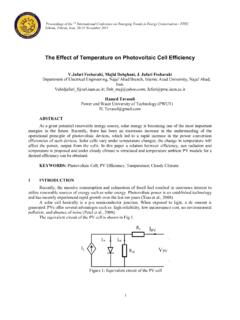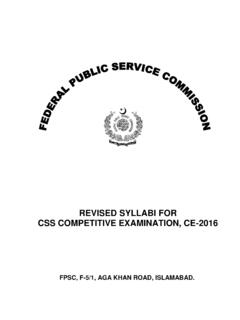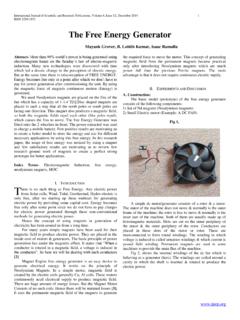Transcription of ENERGY EFFICIENT AND SUSTAINABLE ARCHITECTURE
1 Department of ARCHITECTURE , National Institute of Technology: Tiruchirappalli 620 015 0 | P a g e M. Arch. IN ENERGY EFFICIENT AND SUSTAINABLE ARCHITECTURE CURRICULUM and SYLLABUS (For students admitted in 2016-17) DEPARTMENT OF ARCHITECTURE NATIONAL INSTITUTE OF TECHNOLOGY TIRUCHIRAPPALLI 620 015 TAMIL NADU, india Department of ARCHITECTURE , National Institute of Technology: Tiruchirappalli 620 015 1 | P a g e M. Arch. ( ENERGY EFFICIENT AND SUSTAINABLE ARCHITECTURE ) CURRICULUM The total minimum credits for completing the programme in ENERGY EFFICIENT AND SUSTAINABLE ARCHITECTURE is 60 . SEMESTER - I CODE COURSE OF STUDY L T P C 1 AR701 ENERGY , ENVIRONMENT & BUILDINGS 2 - - 2 2 AR703 BUILDING SCIENCE & SUSTAINABILITY 3 - - 3 3 AR705 solar PASSIVE ARCHITECTURE 3 - - 3 4 AR707 ASSESSMENT OF BUILT ENVIRONMENT 3 - 3 5 AR709 BUILDING ENERGY ANALYSIS STUDIO - - 6 3 6 ELECTIVE I 2 - - 2 7 ELECTIVE II 2 - - 2 15 - 6 18 SEMESTER II CODE COURSE OF STUDY L T P C 1 AR702 BUILDING ENERGY AUDIT & MANAGEMENT 3 - - 3 2 AR704 GREEN ARCHITECTURE 2 - - 2 3 AR706 LIGHTING DESIGN 3 - - 3 4 AR708 ENERGY EFFICIENT LANDSCAPE DESIGN 3 - - 3 5 AR710 BUILDING MODELLING & SIMULATION LAB - - 6 3 6 ELECTIVE I 2 - - 2 7 ELECTIVE II 2 - - 2 15 - 6 18 Department of ARCHITECTURE , National Institute of Technology.
2 Tiruchirappalli 620 015 2 | P a g e SEMESTER III CODE COURSE OF STUDY L T P C 1 AR747 DISSERTATION PHASE I - - 24 12 SEMESTER IV CODE COURSE OF STUDY L T P C 1 AR748 DISSERTATION PHASE II - - 24 12 LIST OF ELECTIVES Sl. No. CODE ELECTIVES L T P C 1 AR711 STATISTICS FOR ENVIRONMENTAL DESIGN 2 - - 2 2. AR713 ENVIRONMENT & BEHAVIOUR 2 - - 2 3. AR715 ENVIRONMENTAL LIGHTING 2 - - 2 4. AR717 NATURAL VENTILATION 2 - - 2 5. AR712 RESEARCH METHODS 2 - - 2 6. AR714 HEALTHY BUILDINGS 2 - - 2 7. AR716 INTELLIGENT BUILDINGS 2 - - 2 8. AR718 POST OCCUPANCY EVALUATION OF BUILDINGS - - 4 2 Department of ARCHITECTURE , National Institute of Technology: Tiruchirappalli 620 015 3 | P a g e SYLLABUS AR 701 ENERGY , ENVIRONMENT & BUILDINGS Nature and extent of the ENERGY and environmental crises facing the world and the country. Need for implementing ENERGY efficiency on an international, national and individual basis in the context of the building industry & environmental issues.
3 ENERGY consuming sectors in the country. Primary, delivered and end use ENERGY . Indoor environment spatial environment, Thermal environment, visual environment, sonic environment and olfactory environment. Concept of Total Comfort. Human comfort and its assessment. Factors influencing comfort in solar passive buildings. Concept of embodied ENERGY . Embodied ENERGY for material and building component. ENERGY for production of building materials. Total ENERGY need for building. Functional factors, environmental factors, envelope factors, air-conditioning systems factors, ENERGY source factors and electrical systems factors. ENERGY conservation / efficiency codes and & Techniques of ENERGY performance assessment of buildings. REFERENCES: 1. Baker Nick and Steemers Koen, ENERGY and Environment in ARCHITECTURE , E & FN Spon, London, 1999.
4 2. Goulding, John, R., Lewis, Owen, J., and Steemers, Theo, C., ENERGY in ARCHITECTURE , Bastford Ltd., London, 1986. 3. Bansal Narendra, K., Hauser Gerd and Minke Gernot, Passive Buildings Design: A Hand book of Natural Climatic Control , Elsevier Science, Amsterdam, 1994. 4. Givoni, B., Man, Climate and ARCHITECTURE , Elsevier, Amsterdam, 1986. 5. Smith, R. J., Phillips, G. M., and Sweeney, M., Environmental Science , Longman Scientific and Technical, Essex, England, 1982. 6. Watson Donald, Climate Design: ENERGY EFFICIENT Building principles and practices , McGraw Hill Book Company, New York, 1983. Department of ARCHITECTURE , National Institute of Technology: Tiruchirappalli 620 015 4 | P a g e AR 703 BUILDING SCIENCE AND SUSTAINABILITY Heat transfer processes in buildings. Thermal conductivity, resistance, transmittance, surface characteristics, surface coefficient, heat capacity, insulation.
5 Calculation of principle building ENERGY gains and losses. Estimation of building ENERGY performance for heating and cooling for different climatic contexts. Importance of ENERGY to human development, conventional and renewable ENERGY sources supply, uses and environmental impact. Assessment future growth in ENERGY demand, availability, potential for SUSTAINABLE development. SUSTAINABLE issues of planning, building design and development. References: 1. Baird, George The architectural expression of environmental control systems 2001. 2. Faber, Oscar and Kell, Heating and air-conditioning of buildings. 2002. 3. Thomas, Randall & Fordham Max SUSTAINABLE urban design:an environmental approach 2003. 4. Edwards, Brian and Hyett, Paul Rough guide to sustainability 2001. 5. Langston, Craig A. and Ding, Grace SUSTAINABLE practices in the built environment 2001. 6. Givoni Baruch, Passive and Low ENERGY Cooling of Buildings ,VNR, New YorK, 1994.
6 7. Martin J Gainsborough, Radford and Helen Bennets, T J Williamson, Understanding SUSTAINABLE ARCHITECTURE , Spon Press, London, 2003. AR 705 PASSIVE solar ARCHITECTURE Classification of passive cooling systems according to the major natural source from which the cooling ENERGY is derived. Minimizing cooling needs by building design: building shape & layout, orientation, size of windows, shading of window, colour of the envelope and climatic impact of plants around building. Radiative cooling The earth as a cooling source for buildings. Cooling of attached outdoor spaces. Passive solar configuration outline of various passive systems for heat gain. Direct Gain, Indirect Gain Trombe wall, Water wall and Transwall. Sun space / attached solarium / conservatory. Roof Pond / Skytherm Vary Therm Wall Earth sheltered / earth bermed structures and earth-air tunnels.
7 The use of earth-air tunnels to heat or cool the buildings. Department of ARCHITECTURE , National Institute of Technology: Tiruchirappalli 620 015 5 | P a g e REFERENCES: 1. Givoni Baruch, Passive and Low ENERGY Cooling of Buildings , Van Nostrand Reinhold, New Yord, 1994. 2. Sodha, M., Bansal, N. K., Bansal, P. K., KuMEB, A., and Malik, M. A. S., solar Passive Buildings , Pergamon Press, Oxford, 1986. 3. Bansal Narendra, K., Hauser Gerd and Minke Gernot, Passive Buildings Design: A Hand book of Natural Climatic Control , Elsevier Science, Amsterdam, 1994. 4. Goulding, John, R., Lewis, Owen, J., and Steemers, Theo, C., ENERGY in ARCHITECTURE , Bastford Ltd., London, 1986. AR 707 ASSESSMENT OF BUILT ENVIRONMENT Evolution and conceptual framework of building performance evaluation. Methods and phases of assessing building performance strategic planning effectiveness review, program review, design review, construction commissioning, post occupancy evaluation, adaptive reuse/recycling market/needs assessment.
8 Bench marking the sustainability of a building project. Case studies of assessing the performance of buildings. Human elements in building performance evaluation. Tools for performance evaluation. Reference: 1. Preiser Wolfgang F E and Jacqueline C Vischer, Assessing Building performance Elsevier limited, London, 2004. 2. Mat Santamouris, ENERGY performance of residential buildings , James & James, London, 2005. 3. Katrina Buff (ed), ENERGY & High performance facility source book , Fairmont Press, Lilburn 2003. 4. Wolfgang F E Preiser, Building Evaluation , Springer, 1989. AR 709 BUILDING ENERGY ANALYSIS STUDIO Exploration of a range of analytical and design tools. Understanding of capabilities of limitations of various ENERGY analysis tools. Tools to be explored solar shadow modeling tools, heat flow analysis, light simulation tools, modeling of ventilation, fire dynamics, sizing of passive solar features, estimation of ENERGY Department of ARCHITECTURE , National Institute of Technology: Tiruchirappalli 620 015 6 | P a g e conservation.
9 Studio projects involve design and evaluation of buildings to demonstrate ENERGY analysis and efficiency of building designs. References: 1. Dennis Landsberg & Ronald Stewart, Improving ENERGY Efficiency in Buildinngs : A management guide , State University of New York Press, Albany, 1980. 2. M. Santamouris, ENERGY Performance of Residential Buildings , James & James, London 2005. 3. Moncef Krarti, ENERGY Audit of Building Systems: an Engineering approach CRC Press, LLC, Florida 2000. 4. Chris P Underwood and Francis W H Yik, Modelling methods for ENERGY in Buildings , Blackwell publishing co., Oxford 2004. 5. Katrina Buff (ed), ENERGY & High performance facility source book , Fairmont Press, Lilburn 2003. AR 702 BUILDING ENERGY AUDIT AND MANAGEMENT An overview of ENERGY consumption and its effects. Current ENERGY consumption scenario in india . Need to reduce emissions.
10 Aims and main aspects of ENERGY management of buildings. Benefits and methodology for conducting the Historical ENERGY audit. Objectives & benefits and conducting Diagnostic ENERGY Audit. Instrumentation. ENERGY management matrix as a tool to diagnose the current state of ENERGY management in any given organization. Management issues covered in the matrix ENERGY policy, organization, motivation, information systems, Marketing & investment. Determining the organizational profile. Monitoring & Targeting of ENERGY use. Identification of opportunities for reducing ENERGY consumption improvements to the building fabric & building services. Details of building ENERGY survey building information, building physical data, building envelope construction details, mechanical systems, electrical systems & equipment, hot water systems, indoor environmental conditions for each space, control systems and operating schedules.


